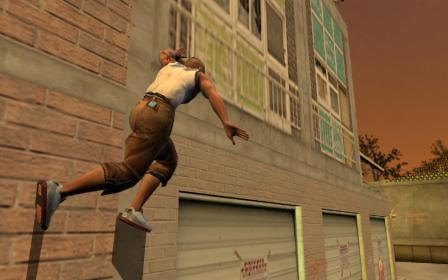You can trust VideoGamer. Our team of gaming experts spend hours testing and reviewing the latest games, to ensure you're reading the most comprehensive guide possible. Rest assured, all imagery and advice is unique and original. Check out how we test and review games here
Though it might not seem like the most obvious of comparisons, free runners have a fair amount in common with the gaming hardcore who queue up for two days to get their hands on the latest console, and it’s not just that both groups congregate down side streets in most city centres.
Like the sleeping bag wearing Otaku, free runners attract a lot of media attention, but it’s rare you’ll actually meet one. Free running, or parkour, might just be the most over-hyped and under-participated sport in the world. It has existed for decades in one form or another, but jumping across huge gaps onto tiny railings was made world famous by Sebastien Foucan and his band of athletes around the turn of the millennium. Those French pioneers have certainly promoted their pastime well, having appeared in adverts, movies and documentaries, with a hefty scene in Casino Royal marking their most prominent and recent flirtation with fame.
Whether you see it as a glorious art form that challenges our perceptions of the urban jungle, or a poor man’s skateboarding made trendy buy a gang of chancers with delusions of grandeur, parkour clearly has a lot of potential to make a great videogame.
It is Rebellion’s harnessing of this potential that has defined Free Running, a game that keeps you hooked with a promise that things are about to get so much better, without every actually reaching those heights.
Predictably, it takes the form of most extreme sports games, with goals and challenges hidden around a selection of stereotypically urban environments. It certainly has its own distinct elements, but Free Running seems hesitant to show these off, instead concentrating its efforts on being something it shouldn’t; namely Tony Hawk’s Pro Walking.
The thing that makes the infamous Activision sports games so popular is the speed and fluidity that comes from having a bike, skateboard or similar under your feet. Though free runners, or traceurs, are fluid, speedy, and unbelievably brave, it is when the game tries to ape the goals of Tony Hawk that things get ugly. Dashing about collecting hidden icons or racking up a monstrous score just feels slightly clumsy and forced when your avatar is on foot, and as well meant as the goals are, many are just too frustrating.
Where Free Running succeeds is when it sets missions that encourage you to act like a free runner. The best goals are those that require you to cross an area without touching the floor, like an only-child in a room full of furniture. Though you’ll often only be two feet above the ground, spotting a stepping stone route across railings and bollards, and then deftly leaping across is mostly brilliant, bringing an addictive puzzle feel to an otherwise lacking game. Each of these traversing tasks is laid out with enough variation to avoid a sense of repetition, and often involve some inspired level design by the developers.
Sadly, that is almost the only part of Free Running that is especially good. The graphics on the whole constantly remind of how dated the earliest days of the PlayStation 2 now look, and the technical shortcomings are joined by a lack of artistic flair and unimaginative level design. Most of the gritty urban areas are an ugly smear of grey and brown, and the identikit objects that sparsely litter the floor have a definite PSP feel about them – perhaps not surprising considering Free Running is indeed available on Sony’s handheld.
The goals on each level follow a rather dreary and formulaic system. The first goal is restricted by a time limit, and involves opening up the level’s areas by completing several mini-goals. Once this is complete you can begin to tackle the rest of the level and the full-sized challenges. This sounds like a nice way of encouraging the player to explore and familiarise themselves with the level before tackling the more trying tasks but in reality the latter goals are just larger copies of the mini-goals. This lends the game a mind numbing sense of repetition, which is compounded further by the fact that as you reach a new level the objectives presented are almost identical to the set you have just completed.
The range of tricks on offer are fairly varied and numerous, and Free Running must be praised for including a control system that doesn’t blindly ape the proven Tony Hawk recipe of button mashing. Although it only allows for fluid movement from time to time, when it does work it certainly lets you to feel at one with the angular concrete, as you vault over railings and slide down slopes.
Most of the more showy tricks are assigned to combinations of the front shoulder buttons, capped off with a press of a face button. The resulting acrobatics are a little like those gymnasts perform on the floor at Olympic events, but unfortunately the correlation between the movements of your fingers and the body of you traceur is so abstract it is hard to remember any one of them when a mission demands it.
A sense of unfulfilled potential runs throughout Free Running. It is unlikely that it will sell in vast quantities, but if it does make enough to spawn sequels it has every chance of reaching maturity within a few iterations. For now though, it is only recommended for the die-hard parkour fans.
Free Running
- Platform(s): PC, PlayStation 2, PSP
- Genre(s): Action, Arcade, Sport, Sports
/https://oimg.videogamer.com/images/ae37/free_running_4-35045.jpg)






